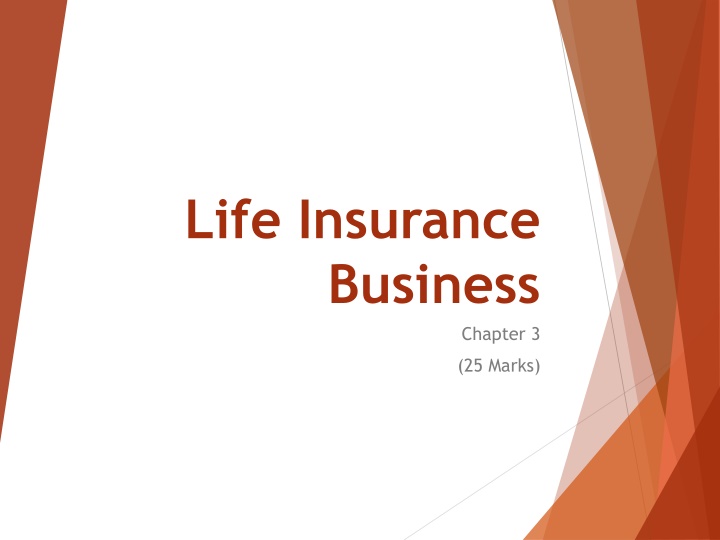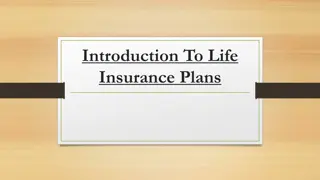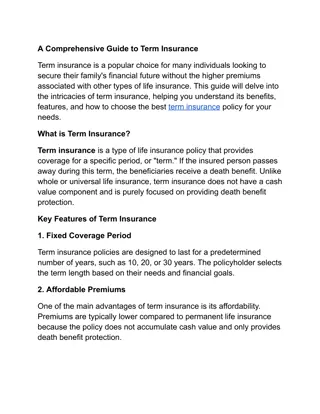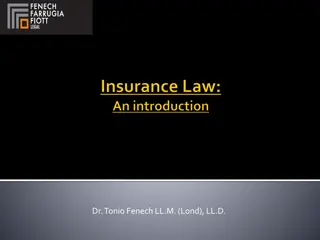Life Insurance Business
Life insurance is a crucial financial tool providing peace of mind and security. It involves a contract between a policyholder and an insurance company, where the company pays a sum to the insured's family upon death in exchange for premium payments. Key features include the policyholder, premium, maturity, insured individual, sum assured, policy term, nominee, and claims process. Benefits include risk coverage, different plans, health expense coverage, savings and wealth creation, guaranteed income, loan facility, and tax benefits.
Download Presentation

Please find below an Image/Link to download the presentation.
The content on the website is provided AS IS for your information and personal use only. It may not be sold, licensed, or shared on other websites without obtaining consent from the author.If you encounter any issues during the download, it is possible that the publisher has removed the file from their server.
You are allowed to download the files provided on this website for personal or commercial use, subject to the condition that they are used lawfully. All files are the property of their respective owners.
The content on the website is provided AS IS for your information and personal use only. It may not be sold, licensed, or shared on other websites without obtaining consent from the author.
E N D
Presentation Transcript
Life Insurance Business Chapter 3 (25 Marks)
Life Insurance-Meaning Life Insurance is defined as a contract between the policy holder and the insurance company, where the life insurance company pays a specific sum to the insured individual's family upon his death. The life insurance sum is paid in exchange for a specific amount of premium. Life is beautiful, but also uncertain. Whatever you do, however smart and hard you work, you are never sure what life has in store for you. It is therefore important that you do not leave anything to chance, especially life insurance . As death is the only certain thing in life, apart from taxes, it pays to insure it well in advance.
Features of Life Insurance Policyholder: Policyholder is the individual who pays the premium for the life insurance policy and signs a life insurance contract with a life insurance company. Premium:A premium is the cost the policyholder pays the life insurance company for covering his/her life. Maturity: Maturity is the stage at which the policy term is completed and the life insurance contract ends. Insured: Insured is the individual whose life is secured via the life insurance. After his/her death the insurance company is accountable to provide a financial amount to the dependents.
Sum Assured: The amount the insurance company pays the dependents of the insured if those events occur which are specified in the life insurance contract. Policy Term: Policy term is the specified duration (listed in the life insurance contract) for which the insurance company provides a life cover and the time period during which the contract is active (listed in the life insurance contract). Nominee: A nominee is an individual listed in the life insurance contract who is entitled to receive the predetermined compensation, as a part of the policy. Claim: On the insured's demise, the nominees can file a claim with the insurance provider in order to receive the predetermined payout amount.
Benefits of Life Insurance 1. Risk Coverage: Insurance provides risk coverage to the insured family in form of monetary compensation in lieu of premium paid. 2. Difference plans for different uses: Insurance companies offer a different type of plan to the insured depending on his need for insurance. More benefits come with the more premium. 3. Cover for Health Expenses: These policies also cover hospitalization expenses and critical illness treatment. 4. Promotes Savings/ Helps in Wealth creation: Insurance policies also come with the saving plan i.e. they invest your money in profitable ventures. 5. Guaranteed Income: Insurance policies come with the guaranteed sum assured amount which is payable on happening of the event. 6. Loan Facility: Insurance companies provide the option to the insured that they can borrow a certain sum of amount. This option is available on selected policies only. 7. Tax Benefits: Insurance premium is tax deductible under section 80C of the income tax Act, 1961
Objectives of Life Insurance With life insurance in place, you can: Ensure your mortgage is paid and your family is comfortable after your death Avoid infighting among survivors over your remaining assets Cover costs like funeral expenses and estate taxes Provide liability protection for your estate
Contents of life insurance policy Heading It contains the name and address of the insurer, jurisdiction in legal disputes etc. Preamble It states the intention of the parties to the contract in brief & in general terms. It introduces both the parties, the receipt of the proposal and the declaration Operative Clause It mentions the mutual responsibilities of obligation of both the parties Proviso It contains a stipulation. Conditions printed on back of the policy shall be deemed to be part of the policy. Every endorsement placed evidencing alteration etc.
Schedule It contains details of particular contract. Classification as under: Policy no, date of commencement, name and address of the proposal and life assured. Plan of the term, sum assured, date of maturity, events on the happening of which benefits are payable Details of nominee Premium amount to be paid, due dates, mode of payment, last date of premium payment etc. Age of life assured and its admission Attestation: Duly signed and stamped by authorized official of the company
Condition of privileges: They are usually printed on the back of the policy document Conditions It explains the nature of the contract. For instance premium is calculated based on the age and if age has been proved to be higher or not stated correctly the co. reserves the right to modify any terms of the contract. 1. Forfeiture of policy Non payments of premium Incorrect or untrue statement In the event of any condition being contravened #Suicide: The condition stipulates that in the event od death due to suicide, within a year from the commencement of policy the risk shall be void. 2. Privileges: Certain privileges are allowed under a policy. For e.g. payment of premium, days of grace are allowed
Documentation in life insurance contracts Proposal form It contains questions designed to collect all material information about the particular risk proposed for insurance. Proposals name in full Address, profession, occupation Previous and present insurance cover Loss experience Sum insured Signature, date, place etc. Policy forms It is the document which provides evidence of the contract of insurance
Cover note It is a document issued in advance if due to some reason the policy document cannot be issued right away. It is a temporary in nature and is valid for a specific period of time. Certificate of issuance It provides evidence of insurance to the police and registration authority. It contains essential features of insurance covers including the terms and conditions Endorsements If the insurer needs to modify the policy terms and conditions it is done by setting out an alteration in the memorandum attached to the policy and forms the part of it. This memorandum is called an endorsement.
Procedure for issuing life policy Scrutinizing the age proved in with the document provided 1. Medical examination if deemed necessary 2. Identifying the nominee in the event of death of the policy holder 3. Stating the conditions of agreeing to conditions of revivals, policy loans, surrender value etc. 4. Stating and agreeing to the conditions regarding death claim, maturity claim etc. 5.
Types of Life Insurance policies Basic elements in life insurance cover: Death cover Plans which provide only death cover are called Term Insurance Plans Risk cover The benefits which are paid on the survival of insured person within the specified period is called Pure End Plans
Important life insurance policies Whole Life Insurance A whole life insurance policy covers the life assured for whole life, or in some cases, up to the age of 100 years. Unlike, term plans, which are for a specified term. The sum assured or the coverage is decided at the time of policy purchase and is paid to the nominee at the time of death claim of the life assured along with bonuses if any. Endowment Plans Endowment plan is another type of life insurance plan, which is a combination of insurance and saving. A certain amount is kept for life cover insurance, while the rest is invested by the life insurance company. In an endowment plan, if the life assured outlives the policy term, the insurance company offers him the maturity benefit.
Money Back Life Insurance Money back plan is a unique type of life insurance policy, wherein a percentage of the sum assured is paid back to the insured on periodic intervals as survival benefit. Money back plans are also eligible to receive the bonuses declared by the company from time to time. This way, policyholder can meet short-term financial goals. Retirement Plan Retirement plan helps to build corpus for your retirement. Helping you to live independently financially and without worries. Most of the child plans provide annual installments or one time payout after the age of 60 years. Group insurance Group Insurance covers a defined group of people, for example members of a professional association, or a society or employees of an organization. Group Insurance may offer life cover, health cover, and/or other types of personal insurance.
Unit Linked Plans (ULIPs) A unit linked plan is a comprehensive combination of insurance and investment. The premium paid towards ULIP is partly used as a risk cover (insurance) and partly is invested in funds. One can invest in different funds offered by the insurance company depending on his risk appetite. The insurance company then invests the accumulated amount in the capital market i.e. in bonds, equities, debts, market funds, or a hybrid funds Child Plan Child plan helps to build corpus for child s future growth. Child plans help to build funds for child s education and marriage. Most of the Child Plan provides annual installments or one time payout after the age of 18 years. In case of an unfortunate event, the insured parent passes away during the policy term - immediate payment is payable by the insurance company. Some child plans waive off the future premiums on death of the life insured and the policy continues till maturity.
An overview of Lump Sum Policies Most people prefer to buy a single premium life insurance policy when they have a lump sum available with themselves. It may be a hefty tax fund, a cash gift from a relative an inheritance or some windfall gains in case of business owners. If you do not wish to spend this money right away and are wary of investing it in the markets, or you think there is some more insurance cover you could do with, you can certainly opt for a single premium life insurance policy. Since the policy is paid up in full upfront you never have to worry again about the policy getting lapsed in case you forget to pay the premium. It is valid till the entire term of the policy and renders the sum assured after the policy term comes to an end. Creates cash value.
Installment/Annuity policies Life annuity is an insurance product in which the annuitant receives a series of future payments for his/her lifetime after retirement. The annuitant has to pay a predetermined payment or a series of regular payments till he/she is working. Life annuity provides financial support to the retirees and helps them maintain a similar standard of living as before retirement. In a life annuity the uncertainty of the annuitant's life span is shifted to the insurer.
Rider benefits A rider is an insurance policy provision that adds benefits to or amends the terms of a basic insurance policy. Riders provide insured parties with options such as additional coverage, or they may even restrict or limit coverage. There is an additional cost if a party decides to purchase a rider. Most are low because they involve very little underwriting. A rider is also referred to as an insurance endorsement. It can be added to policies that cover life, homes, autos, and rental units.
Public & Private sector companies in Life insurance Business in India PUBLIC PRIVATE LIFE INSURANCE CORPORATION OF INDIA HDFC STANDARD LIFE INSURANCE CO LTD MAX LIFE INSURANCE CO LTD ICICI PRUDENTIAL LIFE INSURANCE CO LTD BAJAJ ALLIANZ LIFE INSURANCE CO LTD
Pradhan Mantri Jeevan Jyoti Bima Yojana 2015 Is a government-backed Life insurance scheme in India. It was originally mentioned in the 2015 Budget speech by Finance Minister Arun Jaitley in February 2015.It was formally launched by Prime Minister Narendra Modi on 9 May in Kolkata. As of May 2015, only 20% of India's population has any kind of insurance, this scheme aims to increase the number. Pradhan Mantri Jeevan Jyoti Bima Yojana is available to people between 18 and 50 years of age with bank accounts. It has an annual premium of 330. The GST is exempted on Pradhan Mantri Jeevan Jyoti Bima Yojana. The amount will be automatically debited from the account. In case of death due to any cause, the payment to the nominee will be 2 lakh. This scheme will be linked also to the bank accounts opened under the Pradhan Mantri Jan Dhan Yojana scheme. Most of these account had zero balance initially. The government aims to reduce the number of such zero balance accounts by using this and related schemes. Now all Bank account holders can avail this facility through their net- banking service facility or filling a form at the bank branch at any time of the year. The premium is deducted automatically from the insured's bank account. Insured's family members will receive a sum insured of 2 lac Rupees after insured's death.























